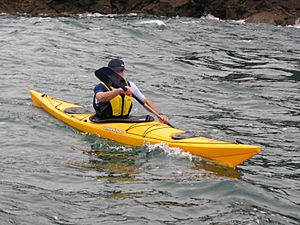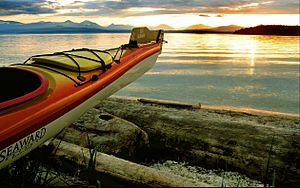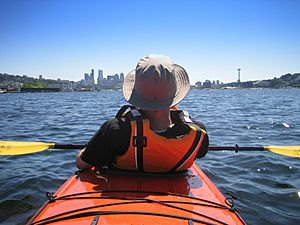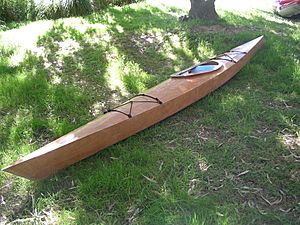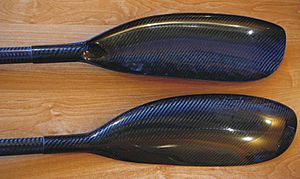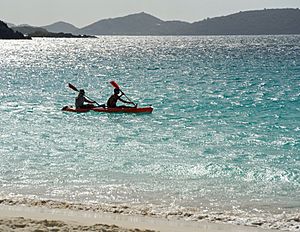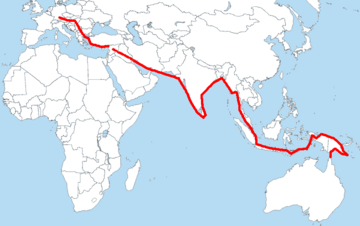Sea kayak facts for kids
A sea kayak is a special type of kayak made for paddling on big, open waters like lakes, bays, and the ocean. These kayaks are strong and safe for the sea. They have a covered top and can use a spray deck to keep water out. Sea kayaks are not as easy to turn as whitewater kayaks, but they are faster. They can carry more gear and are comfortable for long trips.
People around the world use sea kayaks for journeys that can last from a few hours to many weeks. They can hold one to three paddlers, plus space for camping gear, food, water, and other supplies. A solo sea kayak is usually about 3 to 5.5 meters (10 to 18 feet) long. Tandem (two-person) kayaks can be up to 7.9 meters (26 feet) long. They can be narrow, about 53 centimeters (21 inches) wide, or wider, up to 91 centimeters (36 inches).
The name "sea kayak" became popular after a book by John Dowd came out in 1981. Before that, people called it "kayak touring" or "sea canoeing."
Contents
Where Sea Kayaks Came From
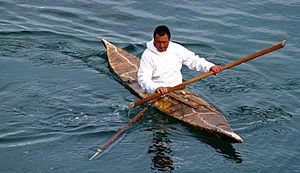
Modern sea kayaks come from the traditional boats made by native people in Alaska, northern Canada, and Southwest Greenland. The Inuit people (also known as Eskimo) created these fast boats to hunt seals and walrus. The ancient Aleut people called their kayaks Iqyak.
The first kayaks were made from a light wooden frame tied with animal tendons or baleen. They were covered with the hides of sea mammals like sea lions or seals. Experts believe kayaks are at least 4000 years old. Wooden kayaks were common until the 1950s, when kayaks made of fiberglass became popular. Plastic kayaks, made by a process called rotomolding, first appeared in 1984.
How Sea Kayaks Are Designed
Today's sea kayaks come in many different materials, designs, and sizes. They are made for various uses. The main types are rigid kayaks and Folding kayaks. Folding kayaks are more like the old traditional boats. They have a frame, often made of ash or birch wood, or modern materials like aluminum. Instead of sealskin, they use strong, waterproof fabrics.
Unlike rigid kayaks, folding kayaks can be taken apart and packed up for easy travel. Many folding kayaks have inflatable tubes called sponsons. These tubes help make the boat more stable and prevent it from flipping over. Recently, inflatable folding kayaks have also become popular.
There are also sit-on-top kayaks that are good for sea use. These boats don't have an enclosed cockpit.
Most rigid sea kayaks look like the old native boats, especially those from Greenland. But strong modern materials like fiberglass, rotomolded plastic, and carbon fiber mean they don't need an inside frame. This makes them heavier. Modern skin-on-frame kayaks use nylon skins and are very light.
Some newer kayak designs include:
- Recreational kayaks: These are shorter and wider with big cockpits. They are made for calm waters.
- Sit-on-top kayaks: These boats don't have an enclosed cockpit. You sit on top of the hull.
- Inflatable kayaks: These can have a removable air bladder inside a tough outer skin, or a single skin like those used in rigid inflatable boats.
In the 1960s, a different type of boat called the surf ski appeared. It's long and narrow, not very stable, and made for riding waves.
Kayak Size
Most sea kayaks are between 3.7 and 7.3 meters (12 and 24 feet) long. The longer ones are often made for two or even three paddlers. The width (beam) of a typical kayak is from 46 to 81 centimeters (18 to 32 inches). Very long kayaks are easier to paddle straight but harder to turn. The width of a kayak affects how much gear it can carry and how stable it is.
Materials Used
Most rigid kayaks today are made from fiberglass, rotomolded polyethylene, or carbon-kevlar. Some are even made from carbon fiber and foam core. You can also find hand-built kayaks made from plywood or wood strips covered with fiberglass. Skin-on-frame kayaks have wood or aluminum frames covered in canvas, dacron, or other fabrics.
Marine grade plywood is very strong and light for building kayaks. Inflatable kayaks can be made from cheaper polyvinyl chloride (PVC) with a nylon outer skin. More expensive ones use a single skin made from hypalon, which is very tough.
Bow, Stern, and Deck
Kayaks have many different designs for their front (bow), back (stern), and top (deck). Some kayaks have bows that curve upwards. This helps them perform better when paddling into waves and shed water. Others achieve this by having more buoyancy in the bow. Kayaks with clear stern decks make some types of self-rescue easier. Modern kayaks have waterproof sections called bulkheads. These help the boat float if it flips over.
Sea kayak decks usually have one or more hatches. These give you easy access to storage space inside. Decks also have places to attach deck lines. These lines help with self-rescue and are used to tie down gear or luggage on deck.
Cockpits can be large or small. A large keyhole cockpit can give you the benefits of both. It allows for good contact between the paddler and the boat, while also being easier to get in and out of.
Equipment and Features
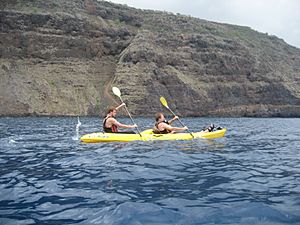
Sea kayaks have many different hull designs, which changes how they perform. Designs can fit different levels of fitness or uses. Shorter boats are usually easier to turn. Longer boats generally go straighter and faster. The width of the boat can affect its stability, speed, and how well it can be tilted on its edge. The amount of rocker (the curve from front to back) greatly affects how well a boat can turn.
Many kayaks have steering or tracking aids like rudders or skegs. Rudders are usually at the back and are controlled by foot pedals in the cockpit. They can be pulled up for landing on beaches. Skegs are straight blades that drop down from the back of the boat. Both rudders and skegs help you paddle straight when strong wind or waves come from the side.
Paddles for Sea Kayaks
Sea kayak paddles come in three main types:
- European
- These paddles have two spoon-shaped blades at each end of a round shaft. This style was first made for fast turns in whitewater kayaking and then used for sea kayaking. European paddles can be made of aluminum, plastic, or wood. The best ones are often made of light materials like carbon-fiber. Often, the two blades are feathered. This means they are set at an angle to each other. This helps with efficiency and reduces wind resistance on the blade that is out of the water.

- Greenland
- These paddles have narrow blades that are rounded near the middle and become oval at the tips. Some have a "shoulder" where the middle part meets the blade. Greenland paddles are usually not feathered. Short Greenland paddles, called storm paddles, are used with a sliding stroke. Your hands move along the blades with each stroke. Storm paddles are often used as spares and in very windy places because they don't catch much wind.
- Wing
- The blade of this paddle is shaped like a wing. When used with a special stroke, the blade creates lift as it moves through the water. This helps the kayaker move forward faster than with other paddles. The paddling style is different from European paddles, but similar to how Greenland paddles work. Wing paddles are mostly used in racing, but also sometimes for touring.
Kayak Dimensions
True sea kayaks are different from wider, more stable recreational kayaks. A solo sea kayak can be from 4.3 to 6.1 meters (14 to 20 feet) long. Tandem kayaks can be from 5.5 to 7.3 meters (18 to 24 feet) long. Sea kayaks are usually 56 to 61 centimeters (22 to 24 inches) wide. Wider touring kayaks (60 to 75 cm or 24 to 30 inches) are better for bigger paddlers. They also offer more initial stability and are easier to turn. Narrower kayaks (50 to 65 cm or 20 to 26 inches) are good for smaller to medium paddlers who want more speed. The depth of a kayak (from the bottom to the highest part of the deck) can be from 28 to 40 centimeters (11 to 16 inches) high.
This design is common for modern sea kayaks. It has a low back deck for easy rolling. It also has a white water cockpit and storage areas that the kayaker can reach while on the water. The sloped back wall helps empty the kayak by lifting the front.
Safety When Sea Kayaking
The most important safety tool in a sea kayak is the paddler themselves. Many kayakers think that knowing how to do an Eskimo roll (a self-righting move) is key for safe open-water kayaking. However, experienced kayakers mostly practice "bracing." Bracing is a technique to keep the kayak upright and avoid flipping in the first place. If you have to roll, it means your brace didn't work. Flipping over in some areas, like rocky surf zones, can be dangerous because you might hit things underwater. Staying upright is super important and comes from good bracing practice.
There are ways to right and re-enter a kayak by yourself after it flips over (capsizes). But most paddlers think it's safest to paddle with others. Help is very useful if your solo recovery fails. It's much easier to get back into a boat in the open sea if another boat and paddler can help you. Still, many experienced paddlers do long trips alone.
A paddle float is a self-rescue tool. It's usually made of foam or is an inflatable bag. You attach it to the end of your paddle when needed. This turns your paddle into an outrigger, helping you climb back into the cockpit. If you use an inflatable paddle float, choose one with two air chambers for extra safety. In some places, like Canada, a paddle float is required by the coast guard. Using a paddle float for re-entry is a reliable way to feel confident paddling, even if your rolling skills aren't perfect.
Sea kayakers often carry a lot of safety gear. This includes a compass, towing lines, hand pumps, repair kits, flares, a paddle leash, spare paddles, and survival gear. They also bring food and hot drinks. Sometimes, they carry GPS devices, maps, lights, radios, cell phones, and radar reflectors.
Different Ways to Sea Kayak
Kayak Sailing
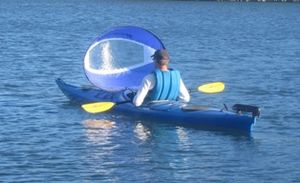
Kayak sails can help you paddle less or even not at all. Using a sail can let you go further offshore and make longer trips possible. Sailing with a kayak is popular with recreational sea kayakers, expedition paddlers, and adventure racers.
Expedition Trips
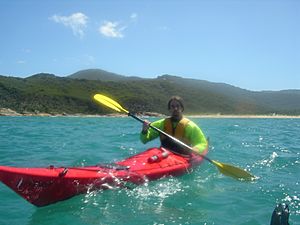
Weekend trips with overnight camping are popular. Many people combine kayaking with watching wildlife. Modern sea kayaks can carry a lot of equipment. This allows for unsupported trips of two weeks or more, even in places from warm tropics to the cold Arctic. Expedition kayaks are designed to work best when loaded with gear.
Surf Kayaking
Surf kayaking Surf skis Surf kayaking is like a mix of surfing and kayaking. Many sea kayaks are made specifically for this sport.
Sea Fishing
Kayak fishing The sea kayak has been used for a long time to travel and reach fishing spots. Kayak fishing has become very popular because there are now stable kayaks made just for it. These special fishing kayaks have features like hatches, built-in rod holders, and places to mount equipment.
Many fishing techniques are the same as those used on bigger boats. The difference is how the equipment is set up on a small kayak. Modern fishing kayaks can have rod holders, electronic fish-finders, and live-bait containers. Kayak anglers catch fish like halibut, cod, and even big ocean fish like amberjacks, tuna, sailfish, and marlin.
Famous Sea Kayak Journeys
- Before 1900
- Some evidence suggests that Inuit paddlers may have crossed the Atlantic Ocean from Labrador or Greenland to Scotland long ago. By the late 1600s, at least three kayaks were kept in Scotland. One kayak, with its gear, is now in Aberdeen's Marischal Museum. It was found on a nearby shore with its dying owner. Some people think these paddlers were Inuit who escaped from European ships, or were blown off course from Greenland. Many believe Inuit and their kayaks are the origin of the Celtic legends of Finn-men or Selkie.
- 1920s
- Franz Romer crossed the Atlantic Ocean alone in a kayak in 1928. His trip from the Canary Islands to Puerto Rico took 58 days. Sadly, he was lost in a hurricane trying to reach New York.
- 1930s
- Oskar Speck paddled from Germany to Australia between 1932 and 1939.
- 1950s
- Hannes Lindemann sailed an Aerius II kayak from the Canary Islands to the Caribbean in 1956. This journey is in his book "Alone at Sea."
- 1960s
- Anne and Hamish Gow made the first kayak crossing from North Uist to St Kilda, Scotland in 1965.
- 1970s
- Derek Hutchinson was the first to cross the North Sea in 1976. He did it in 31 hours after several tries. His kayak is now in the National Maritime Museum Cornwall.
- Nigel Foster and Geoff Hunter were the first to paddle all the way around Iceland in 1977.
- Frank Goodman was the first to paddle around Cape Horn in 1977.
- Paul Caffyn was the first to paddle around the South Island of New Zealand in 1977/78. He wrote about it in his book Obscured by Waves.
- Paul Caffyn was also the first to paddle around the North Island of New Zealand in 1978/79. He wrote about this in Cresting the Restless Waves.
- 1980s
- Paul Caffyn and Nigel Dennis were the first sea kayakers to paddle around Britain in 1980. They covered 3,500 kilometers (2,200 miles) in 85 days.
- Nigel Foster made a solo crossing of Hudson Strait in 1981.
- Paul Caffyn was the first person to paddle around Australia in 1981/82. He covered 15,160 kilometers (9,420 miles) and wrote about it in The Dreamtime Voyage.
- Ed Gillet paddled from California to Hawaii in 1987.
- Howard Rice was the first to paddle solo around Cape Horn in 1989.
- 1990s
- Adventurer Chris Duff paddled around both Ireland in 1996 and New Zealand's South Island in 2000.
- 2000s
- Jon Turk and his team were the first to cross the Bering Strait from Japan to Alaska in 2000.
- Peter Bray crossed from Canada to Ireland in 2001.
- Trys Morris, Gemma Rawlings, and Justine Curgenven successfully paddled around Tasmania in 2004.
- Fiona Whitehead paddled around Great Britain and Ireland in 2004.
- In 2005, Harry Whelan, Barry Shaw, and Phil Clegg were considered the fastest around Britain.
- In November 2005, the Adventure Philosophy team completed the first kayak trip around South Georgia in the Southern Atlantic.
- Andrew McAuley, an Australian solo kayaker, was lost at sea in February 2007. He was only 56 kilometers (30 nautical miles) from his goal in Milford Sound, New Zealand, during his attempt to cross from Australia to New Zealand.
- Justin Jones and James Castrission made the first crossing from Australia to New Zealand in 2008. This was the longest two-person kayak trip ever.
- Freya Hoffmeister completed the "Race Around Australia" in 2009.
- 2010s
- The fastest solo trips around Great Britain were by John Willacy (72 days) and Joe Leach (67 days) in 2012.
- In 2010/2011, Polish kayaker Aleksander Doba crossed the Atlantic from Dakar (Africa) to Fortaleza (South America).
- Freya Hoffmeister completed "The Second Continent," paddling around South America from 2011-2015.
- According to the Guinness Book of World Records, Verlen Kruger paddled the most miles of anyone in the sport, over 160,000 kilometers (100,000 miles).
See also
 In Spanish: Kayak de mar para niños
In Spanish: Kayak de mar para niños
- Folding boat
- Folding kayak
- Hannes Lindemann


